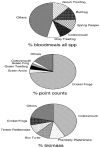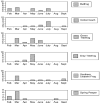Blood feeding patterns of potential arbovirus vectors of the genus culex targeting ectothermic hosts
- PMID: 18981528
- PMCID: PMC4138019
Blood feeding patterns of potential arbovirus vectors of the genus culex targeting ectothermic hosts
Abstract
Reptiles and amphibians constitute a significant portion of vertebrate biomass in terrestrial ecosystems and may be important arbovirus reservoirs. To investigate mosquito preference for ectothermic hosts, feeding indices were calculated from data collected in Tuskegee National Forest, Alabama, USA. Four mosquito species fed upon ectothermic hosts, with Culex peccator and Cx. territans feeding primarily upon ectotherms. These two species appeared to target distinct species with little overlap in host choice. Culex peccator was a generalist in its feeding patterns within ectotherms, and Cx. territans appeared to be a more specialized feeder. Six of eleven ectotherm species fed upon by Cx. territans were fed upon more often than predicted based upon abundance. Spring peepers were highly preferred over other host species by Cx. territans. Blood meals taken from each host species varied temporally, with some hosts being targeted fairly evenly throughout the season and others being fed upon in seasonal peaks.
Figures





References
-
- Edman JD. Host-feeding patterns of Florida mosquitoes (Diptera: Culicidae) VI. Culex (Melanoconion) J Med Entomol. 1979;15:521–525. - PubMed
-
- Irby WS, Apperson CS. Hosts of mosquitoes in the coastal plain of North Carolina. J Med Entomol. 1988;25:85–93. - PubMed
-
- Christensen HA, de Vasquez AM, Boreham MM. Host-feeding patterns of mosquitoes (Diptera: Culicidae) from central Panama. Am J Trop Med Hyg. 1996;55:202–8. - PubMed
-
- Hassan HK, Cupp EW, Hill GE, Katholi CR, Klingler K, Unnasch TR. Avian host preference by vectors of Eastern Equine Encephalomyelitis virus. Am J Trop Med Hyg. 2003;69:641–647. - PubMed
Publication types
MeSH terms
Substances
Grants and funding
LinkOut - more resources
Full Text Sources
